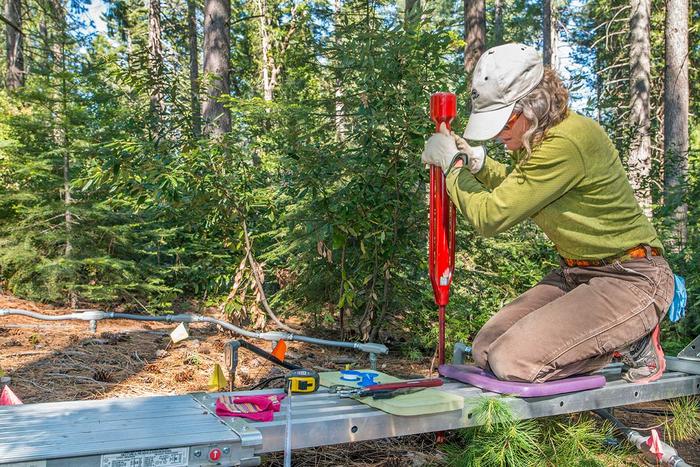A recent study led by scientists at Lawrence Berkeley National Laboratory (Berkeley Lab) and the University of Zurich has revealed that the organic compounds proposed for carbon sequestration in deep soil are highly vulnerable to decomposition under global warming.

Credit: Roy Kaltschmidt/Berkeley Lab
A recent study led by scientists at Lawrence Berkeley National Laboratory (Berkeley Lab) and the University of Zurich has revealed that the organic compounds proposed for carbon sequestration in deep soil are highly vulnerable to decomposition under global warming.
The finding has implications for a key strategy in carbon management that relies on soil and forests – natural carbon “sinks” – to mitigate global warming.
About 25 percent of global carbon emissions are captured by forests, grasslands, and rangelands. During photosynthesis, plants store carbon in their cell walls and in the soil. Because of rich carbon stores from decades past, soils contain twice as much carbon as the atmosphere does, and deeper subsoils (more than 8 inches or 20 centimeters) account for roughly half of the soil carbon. But as global populations rise, so do our demands for new croplands and timber. Research shows that disturbing the natural world for commerce has a price: the United Nations’ Intergovernmental Panel on Climate Change has warned that emissions from deforestation and agriculture account for around a fifth of global greenhouse gases.
“Our study shows that climate change will affect all aspects of soil carbon and nutrient cycling. It also shows that in terms of carbon sequestration, there’s no silver bullet. If we want soil to sustain carbon sequestration in a warming world, we will need better soil management practices, which can mean minimal disturbance of soils during forest management and agriculture,” said Margaret Torn, a senior scientist in Berkeley Lab’s Earth & Environmental Sciences Area and a senior author of the study.
In 2021, Torn and her research team provided the first physical evidence that warmer temperatures lead to a significant drop in the carbon stocks stored in deep forest soils – a loss of 33% over five years.
In the new study, Torn and first author Cyrill Zosso of the University of Zurich unveil a clearer picture of soil in a warming world. This time, the research team is the first to show that warmer temperatures lead to a significant drop in the soil organic carbon compounds that are created by plants during photosynthesis.
During an experiment at the University of California’s Blodgett Forest Research Station in the foothills of California’s Sierra Nevada mountains, the researchers used vertical heating rods to continuously warm 1-meter-deep (three-foot-deep) plots of soil by 4 degrees Celsius (7 degrees Fahrenheit). That is the amount of warming projected by the end of the 21st century if greenhouse gas emissions remain high.
They found that just 4.5 years of warming at this temperature led to large changes in carbon stocks at a depth of more than 30 centimeters (or approximately 12 inches) below the soil surface.
During spectroscopic experiments at the University of Zurich, Zosso identified the organic compounds that were affected by the warming.
The results were shocking: a 17% loss in lignin – the compounds that give plants rigidity – and a nearly 30% loss in cutin and suberin, the waxy compounds in leaves, stems, and roots that protect plants from pathogens.
Torn and Zosso were also surprised to find a significant difference in the amount of “pyrogenic carbon” in the soil samples that were artificially heated versus the ones that were not. Pyrogenic carbon is a type of soil organic carbon derived from charred vegetation and other organic matter remnants left in the wake of a wildfire.
Many researchers assume that pyrogenic carbon has the most potential to serve as a very stable form of sequestered carbon. “We found much less pyrogenic carbon in the deep soils when they were heated,” Torn said.
“Pyrogenic carbon can stay in the soil for decades or even centuries, but we need to understand its vulnerability to warming or to changes in land management. Our study suggests that this material decomposed just as fast as anything else would when the soil was warmed,” Torn explained. “This shows that when you put material deep into soil where it’s in contact with minerals and microbes, those natural systems will decompose the material over time.”
The researchers next plan to resample soil from the study to determine how nine years of warming impact soil composition and health. A new grassland warming experiment at the Point Reyes National Seashore in Northern California is also on the horizon. “We are also organizing all the world’s deep-soil warming (or whole-soil warming) experiments to share data and know-how and conducting synthesis of the data to see what we can learn,” Torn said.
This work was supported by the DOE Office of Science (Office of Biological and Environmental Research) and the Swiss National Science Foundation.
###
Founded in 1931 on the belief that the biggest scientific challenges are best addressed by teams, Lawrence Berkeley National Laboratory and its scientists have been recognized with 16 Nobel Prizes. Today, Berkeley Lab researchers develop sustainable energy and environmental solutions, create useful new materials, advance the frontiers of computing, and probe the mysteries of life, matter, and the universe. Scientists from around the world rely on the Lab’s facilities for their own discovery science. Berkeley Lab is a multiprogram national laboratory, managed by the University of California for the U.S. Department of Energy’s Office of Science.
DOE’s Office of Science is the single largest supporter of basic research in the physical sciences in the United States, and is working to address some of the most pressing challenges of our time. For more information, please visit energy.gov/science.
Journal
Nature Geoscience
DOI
10.1038/s41561-023-01142-1
Method of Research
Experimental study
Subject of Research
Not applicable
Article Title
Rapid loss of complex polymers and pyrogenic carbon in subsoils under whole-soil warming
Article Publication Date
30-Mar-2023




